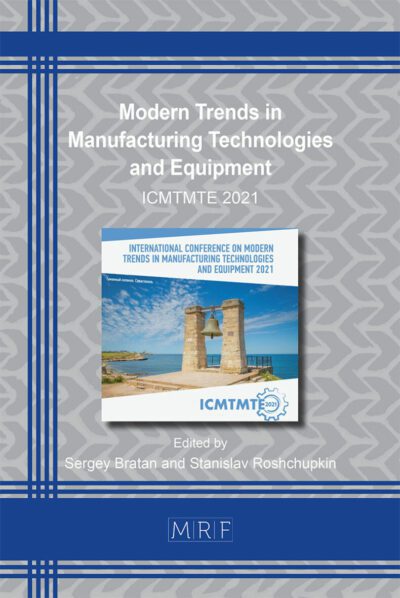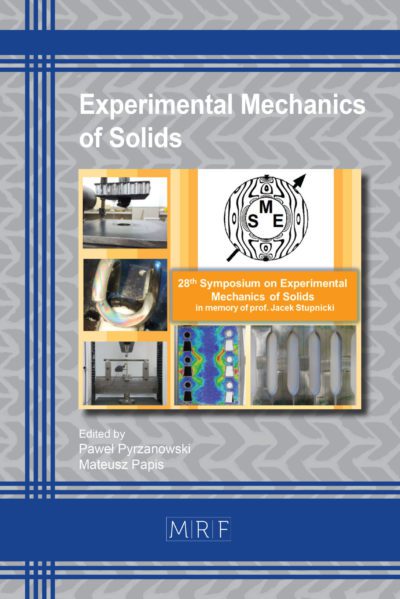Specific behavior of high-manganese steels in the context of temperature increase during dynamic deformation
JABŁOŃSKA Magdalena B., GRONOSTAJSKI Zbigniew, TKOCZ Marek, JASIAK Katarzyna, KOWALCZYK Karolina, SKWARSKI Mateusz, KOSTKA Michał
download PDFAbstract. In recent years, a development of AHSS steels for manufacturing parts for the automotive industry is the observed trend. The high-manganese steels with aluminium and silicon addition, exhibiting twinning induced plasticity (TWIP) effect, are one of the most interesting modern materials, due to their unique combination of both very good strength and great ductility. However, the material behaviour during plastic deformation depends not only on the chemical composition but also on deformation conditions, inter alia, strain rate and temperature. TWIP steels can be used for production of energy-absorbing parts, therefore it is very important to analyse their deformation behaviour at high strain rates. The paper presents the effect of deformation in quasi-static and dynamic conditions on the microstructure of an experimental TWIP steel. The experiments were performed on tensile testing machine and on the flywheel machine. The microstructure was analyzed by optical and scanning transmission electron microscopy. Thanks to the measurements during the quasi-static test and numerical simulations of both tensile tests, the temperature increase was determined in the sample region from which the sections for microstructural studies were taken. It was found that the temperature increase in dynamic conditions can affect the microstructure evolution in the investigated TWIP steel.
Keywords
High-Manganese Steel, TWIP, Dynamic Deformation, Microstructure, Temperature, Twinning
Published online 4/19/2023, 8 pages
Copyright © 2023 by the author(s)
Published under license by Materials Research Forum LLC., Millersville PA, USA
Citation: JABŁOŃSKA Magdalena B., GRONOSTAJSKI Zbigniew, TKOCZ Marek, JASIAK Katarzyna, KOWALCZYK Karolina, SKWARSKI Mateusz, KOSTKA Michał, Specific behavior of high-manganese steels in the context of temperature increase during dynamic deformation, Materials Research Proceedings, Vol. 28, pp 839-846, 2023
DOI: https://doi.org/10.21741/9781644902479-92
The article was published as article 92 of the book Material Forming
![]() Content from this work may be used under the terms of the Creative Commons Attribution 3.0 license. Any further distribution of this work must maintain attribution to the author(s) and the title of the work, journal citation and DOI.
Content from this work may be used under the terms of the Creative Commons Attribution 3.0 license. Any further distribution of this work must maintain attribution to the author(s) and the title of the work, journal citation and DOI.
References
[1] D. Frómeta, A. Lara, L. Grifé, T. Dieudonné, P. Dietsch, J. Rehrl, C. Suppan, D. Casellas,
J. Calvo, Fracture resistance of advanced high-strength steel sheets for automotive applications, Metall. Mater. Trans. A: Phys. Metall. Mater. Sci. 52 (2021) 840-856. https://doi.org/10.1007/s11661-020-06119-y
[2] K.S Raghavan., A.S Sastri., M.J Marcinkowski., Nature of work-hardening behavior in Hadfields manganese steel, Trans. Metall. Soc. Aime 245 (1969) 1569-1575.
[3] L. Remy, Kinetics of fcc. deformation twinning and its relationship to stress-strain behaviour, Acta Metall. 26 (1978) 443–451. https://doi.org/10.1016/0001-6160(78)90170-0
[4] O. Grässel, G. Frommeyer, Effect of martensitic phase transformation and deformation twinning on mechanical properties of Fe-Mn-Si-Al steels, Mater. Sci. Technol. 14 (1998) 1213-1217. https://doi.org/10.1179/mst.1998.14.12.1213
[5] A. Kozłowska, K. Radwański, K. Matus, L. Samek, A. Grajcar, Mechanical stability of retained austenite in aluminum-containing medium-Mn steel deformed at different temperatures, Arch. Civil Mech. Eng. 21 (2021) 269-275. https://doi.org/10.1007/s43452-021-00177-8
[6] Y.F. Shen, N. Jia, R.D.K. Misra, L. Zuo, Softening behavior by excessive twinning and adiabatic heating at high strain rate in a Fe-20Mn-0.6C TWIP steel, Acta Mater. 103 (2016) 229-242. https://doi.org/10.1016/j.actamat.2015.09.061
[7] A. Śmiglewicz, M.B. Jabłońska, The effect of strain rate on the impact strength of the high-Mn steel, Metalurgia 54 (2015) 631-634. ISSN 0543-5846 UDC – UDK 669.74.15:539.55.375:531.76=111
[8] A. Śmiglewicz, W. Moćko, K. Rodak, I. Bednarczyk, M.B. Jabłońska, Study of dislocation substructures in high-Mn steels after dynamic deformation tests, Acta Phys. Polon. A 130 (2016) 942-945. https://doi.org/10.12693/APhysPolA.130.942
[9] H.K. Yang, Z.J. Zhang, F.Y. Dong, Q.Q. Duan, Z.F. Zhang, Strain rate effects on tensile deformation behaviors for Fe-22Mn-0.6C-(1.5Al) twinning-induced plasticity steel, Mater. Sci. Eng. A 607 (2014) 551–558. https://doi.org/10.1016/j.msea.2014.04.043
[10] V. Shterner, I.B. Timokhina, H. Beladi, On the work-hardening behaviour of a high manganese TWIP steel at different deformation temperatures, Mater. Sci. Eng. A 669 (2016) 437-446. https://doi.org/10.1016/j.msea.2016.05.104
[11] M.B. Jabłońska, Structure and properties of a high-manganese austenitic steel strengthened in the result of mechanical twinning in processes of dynamic deformation, Monograph, Silesian University of Technology Publisher, ISBN: 978-83-7880-363-8.
[12] Z. Gronostajski, A. Niechajowicz, R. Kuziak, J. Krawczyk, S. Polak, The effect of the strain rate on the stress-strain curve and microstructure of AHSS, J. Mater. Process. Technol. 242 (2017) 246-259. https://doi.org/10.1016/j.jmatprotec.2016.11.023
[13] M.B. Jabłońska, K. Jasiak, K. Kowalczyk, I. Bednarczyk, M. Skwarski, M. Tkocz,
Z. Gronostajski, Deformation behaviour of high-manganese steel with addition of niobium under quasi-static tensile loading, Mater. Sci.-Poland 40 (2022) 1-11. https://doi.org/10.2478/msp-2022-0029
[14] V. Garcia-Garcia, Microstructural and mechanical analysis of double pass dissimilar welds of twinning induced plasticity steel to austenitic/duplex stainless steels, Int. J. Press. Vessel. Piping. 198 (2022) 104665. https://doi.org/10.1016/j.ijpvp.2022.104665














